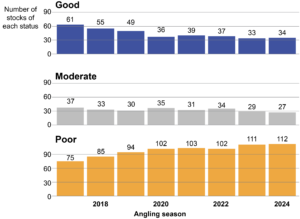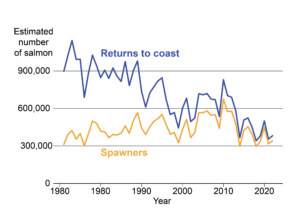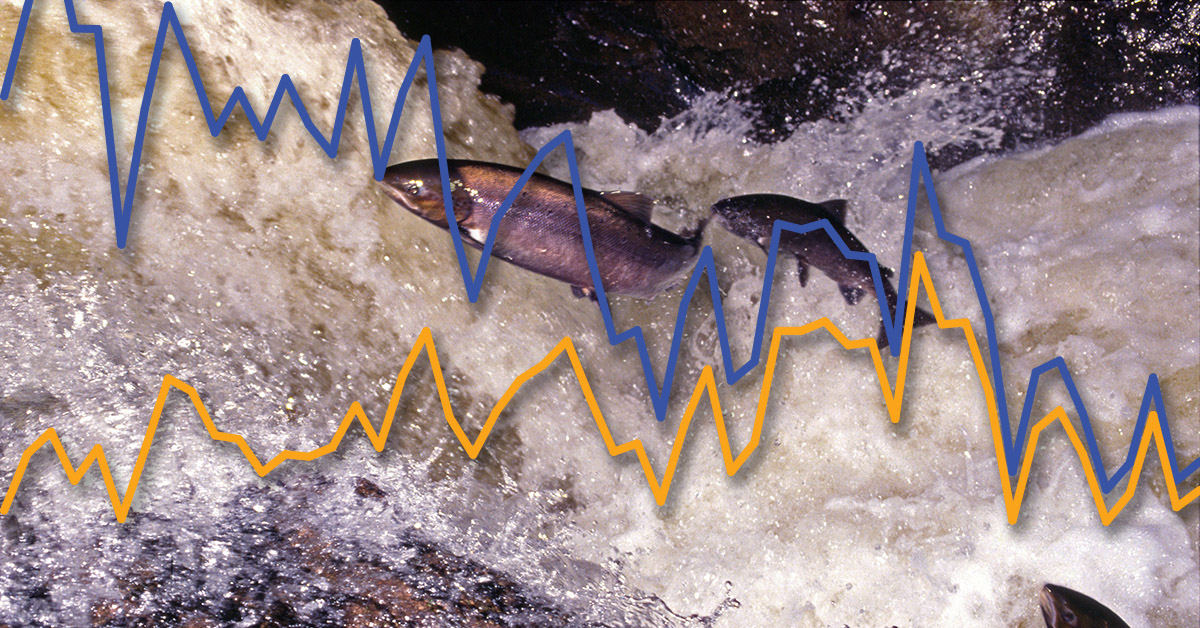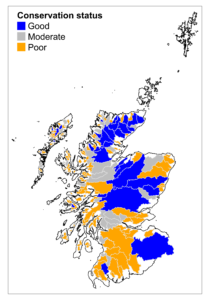Marine
How Scotland’s wild Atlantic salmon are faring
August 16, 2023 by Marine Scotland Communications 26 Comments | Category Freshwater Fisheries
A leaping salmon, achieving the seemingly impossible to return to the upper parts of the very river in which it hatched after a year or more in the ocean, remains one of the most iconic images of Scotland’s wildlife. But how are Scotland’s wild Atlantic salmon faring? As our consultation on proposals for the conservation of Atlantic salmon during the 2024 fishing season launches, we look at some of the scientific data that underpins the management of this remarkable fish.
Every year scientists from the Marine Directorate of the Scottish Government assess the status of 173 Scottish salmon stocks using information collected from river fisheries and automatic fish counters combined with environmental information, such as water flow. The stock levels over the past five years are compared to an internationally agreed benchmark which aims to maintain stocks at sustainable levels. This allows the stocks to be categorized as in good, moderate or poor status with the reduction in salmon numbers driving an increase in the number of stocks in poor status (Figure 1).

Figure 1: The number of stocks assessed as being in good, moderate or poor conservation status (out of 173 stocks) for the 2016-2024 angling seasons.
The larger rivers, which contain most of Scotland’s wild salmon, tend to be in good conservation status. This means that approximately 80% of the total number of fish estimated to be in Scottish rivers are from areas in good conservation status. However, declines in the number of salmon in areas in good conservation status highlights the need for action to safeguard this iconic species.
The proposed grades for the 2024 angling season highlight that the majority of stocks (112 out of 173) are thought to be in poor conservation status and these are spread throughout the country (Figure 2).
The number of wild Atlantic salmon returning to Scottish coastal waters has declined since estimates began in the 1970s (Figure 3).

Figure 3: Estimated number of wild Atlantic salmon returning to the Scottish coast together with estimates of the number surviving to spawn in Scottish rivers (source: returns to coast ICES WGNAS/MSS; spawner numbers MSS).
Fisheries managers have been able to offset these declines by greatly restricting the killing of wild salmon in fisheries, but since around 2010 there has also been a decline in the spawning stock.
The reasons behind the widespread fall in wild salmon numbers in Scotland and across the North Atlantic ocean are highly complex. The evidence suggests that changes in oceanic conditions driven by climate change are at least partly to blame, but it is likely that many different factors in rivers and at sea play a role.
To address the declines and build resilience in salmon populations to the effects of climate change we worked together with multiple partner organisations to develop the Scottish Wild Salmon Strategy and accompanying Implementation Plan.
Alongside reducing pressure from fisheries, actions under the plans include supporting planting riverside trees to shade rivers from rising temperatures and restoring natural river flows by removing obsolete weirs and dams. Steps are also proposed to minimise the impacts of salmon farming on wild populations as well as continuing to co-operate internationally to improve the survival of salmon at sea.
Have your say on proposals for the conservation of Atlantic salmon during the 2024 fishing season by taking part in our consultation which runs until 8 September 2023.
Tags: atlantic salmon, Scottish Wild Salmon Strategy, wild atlantic salmon




SNP’s green energy policy will be the last-nail-in-thecoffin for Scot’s wild salmon and, hopefully, for the SNP.
My local MP has yet to answer a question on Scottish Governments stance on fish farming regarding the (policing of &) aquaculture pollution in our west coast sea lochs. Why they dont impose RAS as law, in this green age, shows how much they, misunderstand the problems here or, care about the environment! Any government that allows foreign ownership to destroy our natural habitats should hang their heads in shame.
I am pleased to see that many other anglers that care about wild salmon are repeating the same issues that are now impacting heavily on our wild salmon stocks as I am. My question is this:- Is anyone actually listening or are Marine Scotland and the Scottish Government simply prepared to ignore these voices and carry on regardless allowing our iconic wild salmon to become extinct in Scottish rivers , taking hundreds of jobs and livelihoods of ghillies and employees of other supporting businesses with it? Some indication that you understand where we are coming from rather than just a deafening silence would be helpful. Is that too much to ask?
The Scottish Government is closing its eyes and scared of making a positive decision regarding the catastrophic decline of our wild Atlantic salmon.
The goosander population has exploded to the extent of crippling our salmon parr stocks.The goosander is not indigenous to Scotland they were unfortunately introduced by ornithologist’s in the latter
part of the twentieth century.Goosander’s numbers “must” be controlled by an increase in numbers to be culled.
For the future safeguarding of the Atlantic Salmon the Scottish Government must take action.
Whale populations are recovering
Tuna are returning to the UK shores and licensed fishing has resumed
Seal populations are thriving
Dolphin numbers are thriving , I saw a shoal of over 100 between Ardnamurchan, and Mull.
Goosanders are now common on most Scottish rivers
Otter numbers are recovering
What is happening to herring ?
What is happening to Mackerel?
Are they in the same boat as Salmon ?
The predators seem to be in strong recovery , but sea trout and salmon numbers are being decimated in our rivers
The balance is wrong , ecology is about getting the balance right.
The seal population is extremely healthy
Something that rarely gets mentioned in the debate is the amount of pollution/effluent that is being deposited into our coastal waters on a daily basis from fish farms. Thousand upon thousand of fish continuously producing tons of fish food waste and excrement into our estuaries. I can’t think of any other industry where this would be tolerated. If anyone would like to see the damage being done by razorbills, cormorants etc send me your email address and I will forward photos of an average days fry consumption. It’s staggering. The SG considers anyone who fishes or shoots to be wealthy toffs or Tories. They’re not interested.
Whats the point in us fishermen doing everything we can by returning looking after fish in a manner to protect them when were fighting a losing battle against these fish eating birds i stay near the river nith last year i stood at white sands dam and watched these birds consume so many young fish i could not beleave what i was see every time they dived down they came up with young fish stocks to swallow time after time all while i stood by helpless to stop this murder in our rivers all across Scotland the pepole who protect these fish eating machines care not for our salmon stocks and that is only one highlighted problem our fish have amongst many there has to be change regarding protecting our salmon against these birds would we stand by and watch poachers fill van loads of fish no but thats whats happening with the fish stock i there is nothing going out to sea there is definitely nothing come back
I agree with everything that’s been said . Protecting spawning steams by promoting organic farming in these areas could be a plus. Silt from inappropriate farming practices near streams and pesticide use have a significant effect on invertebrate life in these vital nursery areas .
How to get agreement to cull seals and goosanders looks like a major priority for salmon survival
I agree 100% that shading of juvenile nursery areas is a great idea, but allowing the protected better shaded smolts to be predated on by the goosander, merganser is lunacy. Then the gauntlet of protected seals?
Has no 1⃣ duduced that the humble fisherman is the ONLY friend the salmon has left. Increased permit costs, barbless hooks, prohibition of shrimping, worming, bag limits reduced to 100% C&R- yet still the numbers fall….Get the false salmon farms on land as in Norway, give more licences to control/reduce saw bills and seals to give these precious fish a chance.Our generation will be judged on what we didn’t do not what we did. RIP SALMO SALAR.
I think that people who blame predators , bird, mammal & marine life for the decline in Salmon stocks are deluding themselves into blaming any other life form that naturally has the salmon in its diet, very seldom do I hear of action taken to find a solution to the decline of this & many other species especially when the solution & cause is staring us right in our faces, ITS US!.We know what we have to do but we don’t seem to have the inclination to do it, all the number crunching , scientific studies, categorising of rivers will not mean a jot if we don’t clean up our act
Seals, fish eating birds, otters, fish farms, pollution, & illegal netting all need urgent vital control. Many anglers (the only source of concern) are in despair, and in frustration leaving the rivers. The problem has been developing to a critical level and action must be applied NOW or wild salmon will be finished.
Politicians need votes. The majority of voting people don’t want culling of predators.
One way might be for the politicians to agree to accept the results and recommendations of an investigation done by a selected mixed group of knowledgeable stakeholders and others.
This would remove the responsibility of making the decision by the politicians.
I don’t think they care enough even to bother
For years now, scientists have been totally against hatcheries to supplement the dwindling numbers of returning fish. Fish face countless obstacles from fish eating birds then seals which are protected and trying to get a licence to control numbers are mostly turned down by the groups that are there to supposedly protect wild salmon. That is crazy! Our current government play only lip service to the problem. For any sake grab the nettle and get salmon open net farms moved onshore in an effort to control sealice numbers and grant our River Boards the authority to deal with inriver predation thus ensuring more smolts get a chance to get out to sea. Everyone can see the decline in numbers but no positive remedies are currently in place. Planting trees is commendable but by the time they mature to give cover for juvenile fish tha salmon will be gone! This is a plea from someone who has fished the Dee for well over 20 years but sadly has decided to cancel henceforth my usual seven visits bringing other four lads with me each time. I estimate that each visit costs me around £900 and multiplying that by four then seven the amount is staggering, and I am only one of many turning my back on a lovely river, not to mention the ghillies and hotels who look after us so we’ll. I’m now 82 years of age and would love nothing more than seeing POSITIVE action to have more of these wonderful creatures returning to their rivers of birth. WHO’S LISTENING ?
Whilst fish farms as a concept are wrong, – hoovering up the wild fish food source to feed to caged fish that are poisoned with antibiotics and other chemicals cannot be right -, they cannot be blamed for wanting to earn a living. The problem is Joe Public eating the filth. I am constantly trying to explain this to all but it falls on deaf ears. They either don’t know or don’t want to know. They don’t appear to realise the connection between their smoked salmon canapés and the declining numbers of wild salmon. Do they care? No. Even amongst fishermen this malaise is ripe. Are they all too frightened to ask their wives to stop buying it? Wake up Fellahs.
With any animal or mammal which is at risk of extinction the authorities step in and commence a full breading program not so the humble salmon a breading program should have started on every river breading to smolt stage for release which would protect the numbers of returning salmon as Iceland has done successfully.
Predation of juveniles by fish eating birds is a massive problem that needs dealing with now…
I believe that declining salmon numbers in the Findhorn are primarily due to desease from fish farms and seal predation in the Findhorn Estuary.
No more studies.! We have all the information and data we need. Ghillies have detailed records going back over many hundreds of Salmon cycles and the current situation is dire. Salmon farms should only be land based. Over fishing at sea by trawlers needs more control. We need to be allowed to manage predators better especially goosanders etc. The impact of the introduction of beavers also needs to be measured. Salmon have no protection at all apart from unlicensed angling !
Surely the immediate issue to be tackled is to help as many smolts as possible, back to sea. Water quality and access are very important, but to give them a real fighting chance, FEB’S now must be controlled. On my local river, cormorant and, especially goosander, are quite prolific. God only knows what this vermin hoover up every day. To have such a valuable, natural asset, which this mealy mouthed government clearly does nothing to protect, is a disgrace.
Here on the Findhorn and round the east coast seals are a huge problem wich needs to be tackled vigorously. Catch and return is all very well but it needs to go hand in hand with restocking programs as well as goosander cormorants and other predators decimating the smooth stocks. Illegal netting round the coasts is another problem that needs to be addressed as well and this actions must taken right now. And finally the scientists have had the say it is time for them to listen to the fisherman now.
I endorse the previous comments and would like to add the effects of the seal population especially on the river mouths where salmon congregate waiting for river levels to rise before making their run to spawn , also the feeder streams must be maintained to allow salmon to reach their spawning grounds, the impact of Beavers will have a huge impact on this. Thank you. Jonathan Gingell.
The Scottish Government has blocked adequate culling of invasive predatory birds like goosanders. It hasn’t issued permits to allow the shooting of seals in rivers far from the sea. It hasn’t allowed various rivers to reopen hatcheries. It completely fails to prosecute salmon farms who flout regulations and have up to 40% mortality in their farmed fish.
It does the easy stuff like river categorisation, but it will not take the difficult but necessary actions listed above. It runs scared of organisations like the RSPB, and focusses on the easy ‘safe’ stuff. Meanwhile native wild salmon disappear from our rivers.
As Mr Mills says the time for procrastination is long past. Bird predation needs to be tackled as a priority. Goosanders Herons Cormorants etc are all protected but the poor old salmon has no protection at all. Salmon farms particularly on the West Coast are spewing thousands of sea lice into coastal waters creating a massive threat to descending migrating smolts. Salmon farming remains unregulated despite several consultations that deemed the status quo was no longer acceptable. Government needs to change or all will be lost.
Fish farms need to be looked at and kept inland or not at all. ‘re stocking is a must and habitat improvement. On the river irvine for example, there are three dams I know of that need removed or broken. Action NOW is needed, what the angler takes home is a drop in the ocean but no angler should take any Salmon just to help things a bit.
It’s time for action and not more studies. Salmon farms should be land based, predators should be controlled especially goosanders etc. The impact of the introduction of beavers also needs to be assessed. Loch Insh need.all the perch removed. I could go on.